Mattingly J.D., Heiser W.H., Pratt D.T. Aircraft Engine Design
Подождите немного. Документ загружается.

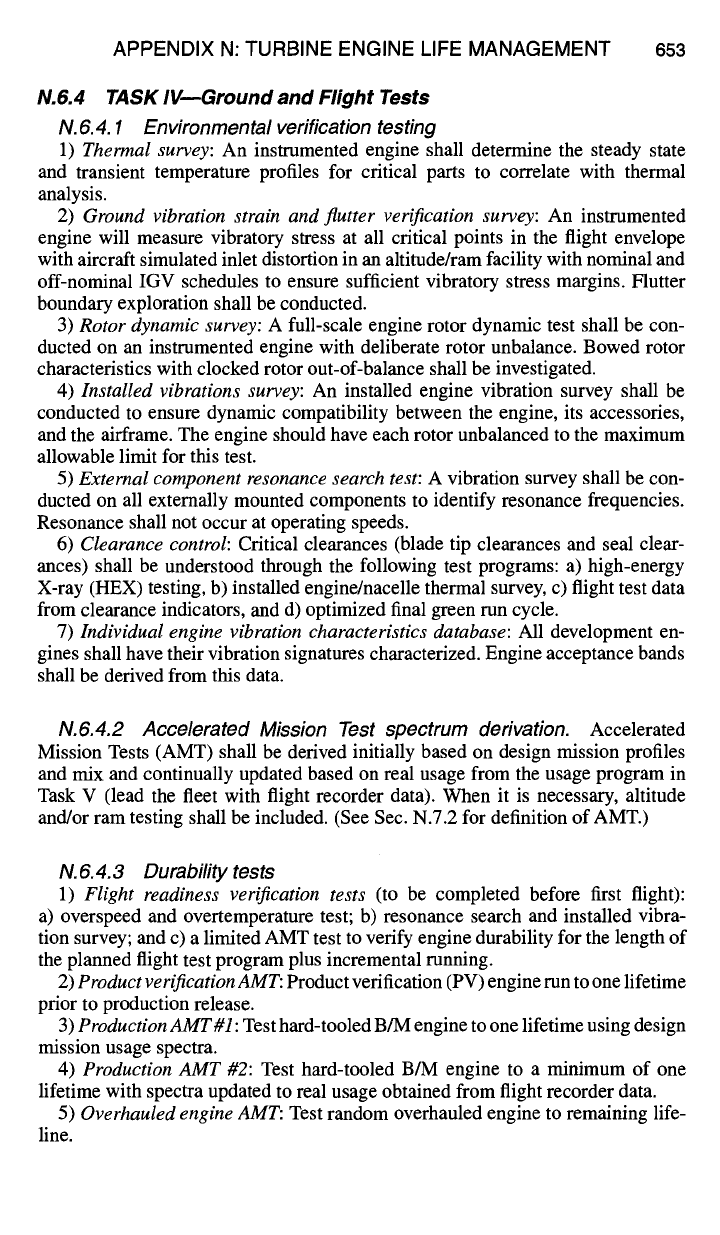
APPENDIX N: TURBINE ENGINE LIFE MANAGEMENT 653
N.6.4 TASK IVmGround and Flight Tests
N. 6.4. I Environmental verification testing
1) Thermal survey: An instrumented engine shall determine the steady state
and transient temperature profiles for critical parts to correlate with thermal
analysis.
2) Ground vibration strain and flutter verification survey: An instrumented
engine will measure vibratory stress at all critical points in the flight envelope
with aircraft simulated inlet distortion in an altitude/ram facility with nominal and
off-nominal IGV schedules to ensure sufficient vibratory stress margins. Flutter
boundary exploration shall be conducted.
3) Rotor dynamic survey: A full-scale engine rotor dynamic test shall be con-
ducted on an instrumented engine with deliberate rotor unbalance. Bowed rotor
characteristics with clocked rotor out-of-balance shall be investigated.
4) Installed vibrations survey: An installed engine vibration survey shall be
conducted to ensure dynamic compatibility between the engine, its accessories,
and the airframe. The engine should have each rotor unbalanced to the maximum
allowable limit for this test.
5) External component resonance search test: A vibration survey shall be con-
ducted on all externally mounted components to identify resonance frequencies.
Resonance shall not occur at operating speeds.
6) Clearance control: Critical clearances (blade tip clearances and seal clear-
ances) shall be understood through the following test programs: a) high-energy
X-ray (HEX) testing, b) installed engine/nacelle thermal survey, c) flight test data
from clearance indicators, and d) optimized final green run cycle.
7) Individual engine vibration characteristics database: All development en-
gines shall have their vibration signatures characterized. Engine acceptance bands
shall be derived from this data.
N.6.4.2 Accelerated Mission Test spectrum derivation.
Accelerated
Mission Tests (AMT) shall be derived initially based on design mission profiles
and mix and continually updated based on real usage from the usage program in
Task V (lead the fleet with flight recorder data). When it is necessary, altitude
and/or ram testing shall be included. (See Sec. N.7.2 for definition of AMT.)
N.6.4.3 Durability tests
1) Flight readiness verification tests (to be completed before first flight):
a) overspeed and overtemperature test; b) resonance search and installed vibra-
tion survey; and c) a limited AMT test to verify engine durability for the length of
the planned flight test program plus incremental running.
2) Product verification AMT: Product verification (PV) engine run to one lifetime
prior to production release.
3) Production AMT#1: Test hard-tooled B/M engine to one lifetime using design
mission usage spectra.
4) Production AMT #2: Test hard-tooled B/M engine to a minimum of one
lifetime with spectra updated to real usage obtained from flight recorder data.
5) Overhauled engine AMT: Test random overhauled engine to remaining life-
line.
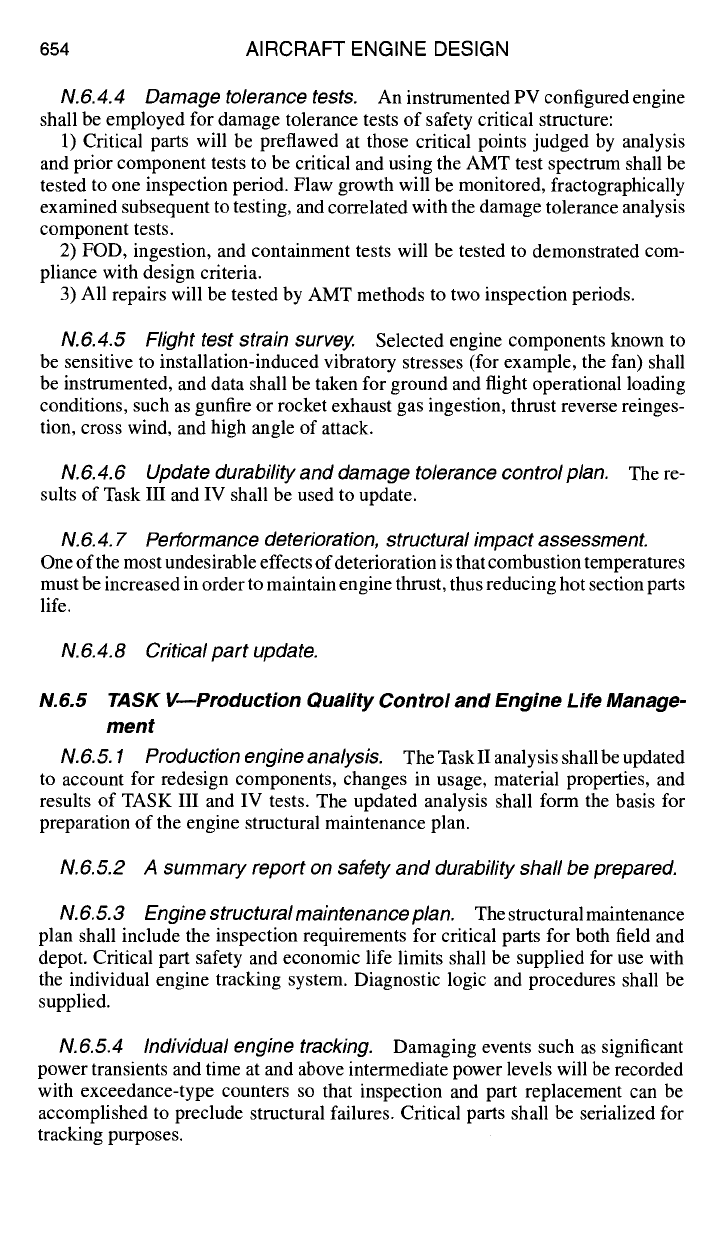
654 AIRCRAFT ENGINE DESIGN
N.6.4.4 Damage tolerance tests.
An instrumented PV configured engine
shall be employed for damage tolerance tests of safety critical structure:
1) Critical parts will be prefiawed at those critical points judged by analysis
and prior component tests to be critical and using the AMT test spectrum shall be
tested to one inspection period. Flaw growth will be monitored, fractographically
examined subsequent to testing, and correlated with the damage tolerance analysis
component tests.
2) FOD, ingestion, and containment tests will be tested to demonstrated com-
pliance with design criteria.
3) All repairs will be tested by AMT methods to two inspection periods.
N.6.4.5 Flight test strain survey.
Selected engine components known to
be sensitive to installation-induced vibratory stresses (for example, the fan) shall
be instrumented, and data shall be taken for ground and flight operational loading
conditions, such as gunfire or rocket exhaust gas ingestion, thrust reverse reinges-
tion, cross wind, and high angle of attack.
N.6.4.6 Update durability and damage tolerance control plan.
The re-
sults of Task III and IV shall be used to update.
N.6.4.7 Performance deterioration, structural impact assessment.
One of the most undesirable effects of deterioration is that combustion temperatures
must be increased in order to maintain engine thrust, thus reducing hot section parts
life.
N.6.4.8 Critical part update.
N.6.5 TASK V--Production Quality Control and Engine Life Manage-
ment
N.6.5. 1 Production engine analysis.
The Task II analysis shall be updated
to account for redesign components, changes in usage, material properties, and
results of TASK III and IV tests. The updated analysis shall form the basis for
preparation of the engine structural maintenance plan.
N.6.5.2 A summary report on safety and durability shall be prepared.
N.6.5.3 Engine structural maintenance plan.
The structuralmaintenance
plan shall include the inspection requirements for critical parts for both field and
depot. Critical part safety and economic life limits shall be supplied for use with
the individual engine tracking system. Diagnostic logic and procedures shall be
supplied.
N.6.5.4 Individual engine tracking.
Damaging events such as significant
power transients and time at and above intermediate power levels will be recorded
with exceedance-type counters so that inspection and part replacement can be
accomplished to preclude structural failures. Critical parts shall be serialized for
tracking purposes.
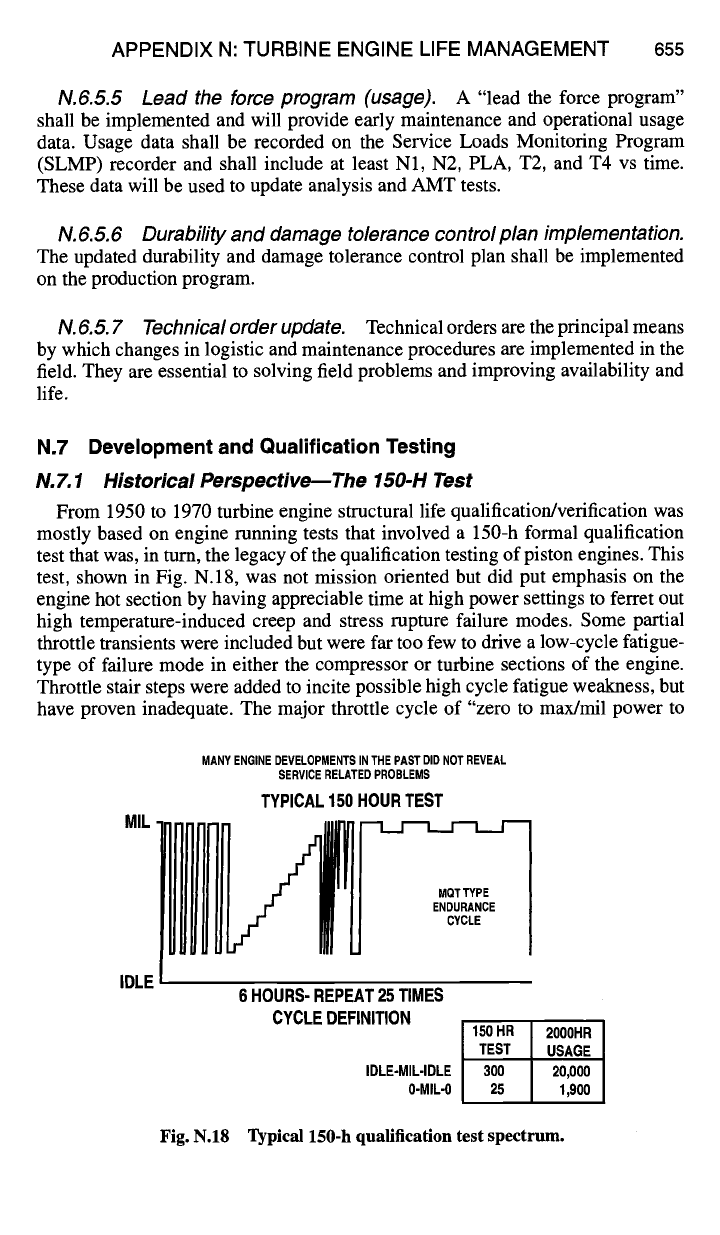
APPENDIX N: TURBINE ENGINE LIFE MANAGEMENT 655
N.6.5.5 Lead the force program (usage).
A "lead the force program"
shall be implemented and will provide early maintenance and operational usage
data. Usage data shall be recorded on the Service Loads Monitoring Program
(SLMP) recorder and shall include at least N1, N2, PLA, T2, and T4 vs time.
These data will be used to update analysis and AMT tests.
N.6.5.6 Durability and damage tolerance control plan implementation.
The updated durability and damage tolerance control plan shall be implemented
on the production program.
N.6.5. 7 Technical order update.
Technical orders are the principal means
by which changes in logistic and maintenance procedures are implemented in the
field. They are essential to solving field problems and improving availability and
life.
N.7 Development and Qualification Testing
N.7.1 Historical Perspective--The 150-H Test
From 1950 to 1970 turbine engine structural life qualification/verification was
mostly based on engine running tests that involved a 150-h formal qualification
test that was, in turn, the legacy of the qualification testing of piston engines. This
test, shown in Fig. N.18, was not mission oriented but did put emphasis on the
engine hot section by having appreciable time at high power settings to ferret out
high temperature-induced creep and stress rupture failure modes. Some partial
throttle transients were included but were far too few to drive a low-cycle fatigue-
type of failure mode in either the compressor or turbine sections of the engine.
Throttle stair steps were added to incite possible high cycle fatigue weakness, but
have proven inadequate. The major throttle cycle of "zero to max/mil power to
MIL -
IDLE
MANY ENGINE DEVELOPMENTS IN THE PAST DID NOT REVEAL
SERVICE RELATED PROBLEMS
TYPICAL 150 HOUR TEST
MQT TYPE
CE
UVUU[/ IllU
6 HOURS- REPEAT 25 TIMES
CYCLE DEFINITION
150 HR 2000HR
TEST USAGE
IDLE-MIL-IDLE 300 20,000
0-MIL-0 25 1,900
Fig. N.18 Typical 15O-h qualification test spectrum.
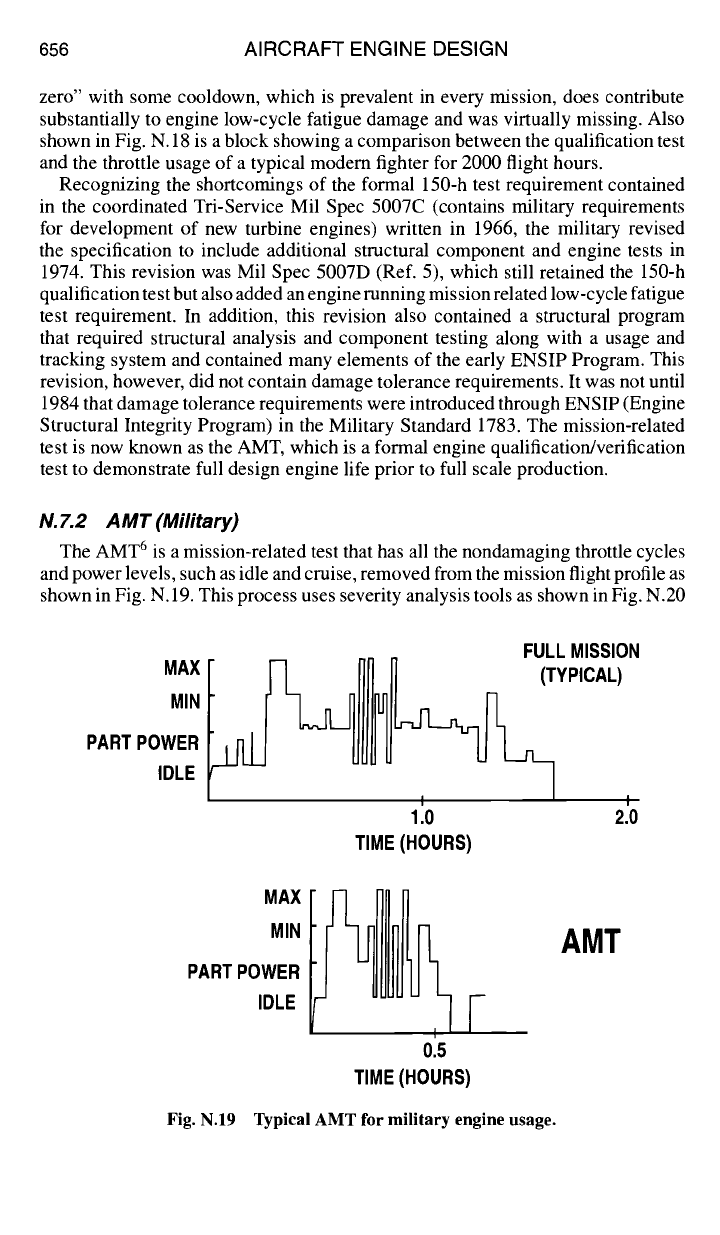
656 AIRCRAFT ENGINE DESIGN
zero" with some cooldown, which is prevalent in every mission, does contribute
substantially to engine low-cycle fatigue damage and was virtually missing. Also
shown in Fig. N. 18 is a block showing a comparison between the qualification test
and the throttle usage of a typical modern fighter for 2000 flight hours.
Recognizing the shortcomings of the formal 150-h test requirement contained
in the coordinated Tri-Service Mil Spec 5007C (contains military requirements
for development of new turbine engines) written in 1966, the military revised
the specification to include additional structural component and engine tests in
1974. This revision was Mil Spec 5007D (Ref. 5), which still retained the 150-h
qualification test but also added an engine running mission related low-cycle fatigue
test requirement. In addition, this revision also contained a structural program
that required structural analysis and component testing along with a usage and
tracking system and contained many elements of the early ENSIP Program. This
revision, however, did not contain damage tolerance requirements. It was not until
1984 that damage tolerance requirements were introduced through ENSIP (Engine
Structural Integrity Program) in the Military Standard 1783. The mission-related
test is now known as the AMT, which is a formal engine qualification/verification
test to demonstrate full design engine life prior to full scale production.
N.7.2 AMT (Military)
The AMT 6 is a mission-related test that has all the nondamaging throttle cycles
and power levels, such as idle and cruise, removed from the mission flight profile as
shown in Fig. N. 19. This process uses severity analysis tools as shown in Fig. N.20
MAX
MIN
PART POWER
IDLE
FULL MISSION
i I
1.0 2.0
TIME (HOURS)
MAX
MIN
PART POWER
IDLE
0.5
TIME (HOURS)
Fig. N.19 Typical AMT for military
engine usage.
AMT
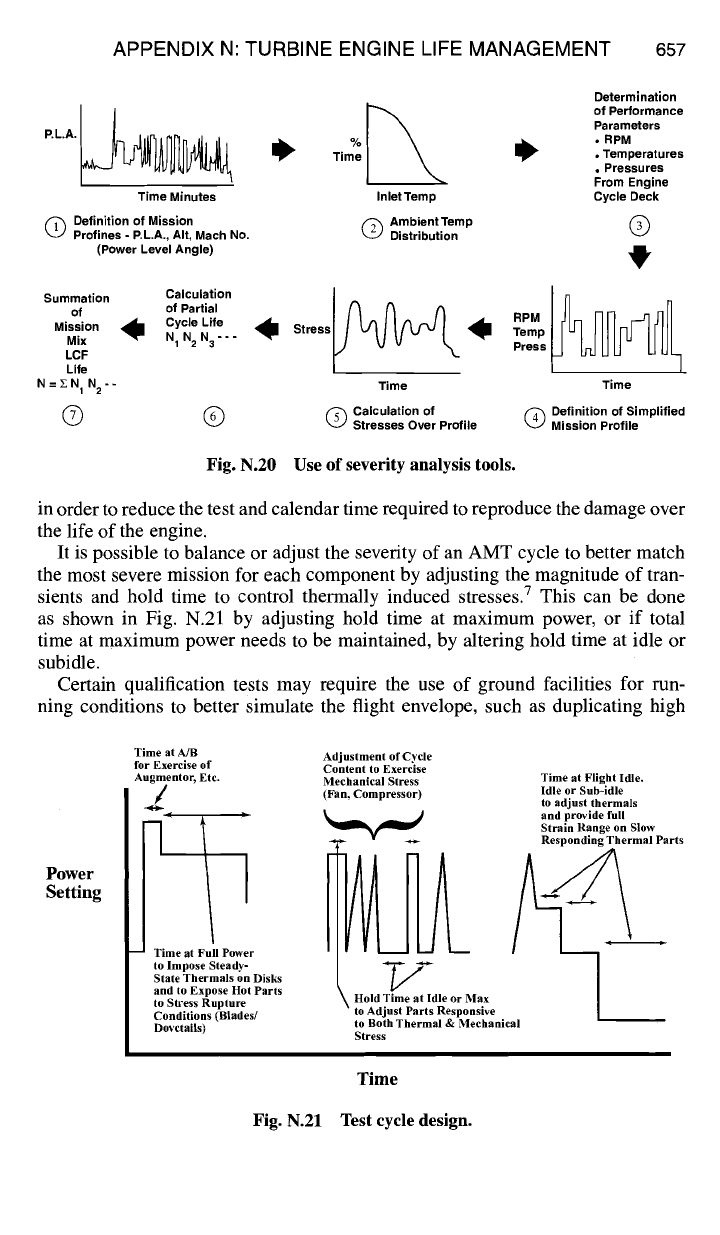
APPENDIX N: TURBINE ENGINE LIFE MANAGEMENT 657
Determination
~~j~ [~ of Performance
Parameters
% o RPM
P.L.A. II~ Time [l~
,
Pressures
• ° Temperatures
From Engine
Time Minutes Inlet Temp Cycle Deck
Definition of Mission
(35
Ambient Temp
Profines - P.L.A., AIt, Mach No. ~-J Distribution
(Power Level Angle)
V
Summation Calculation
of of Partial
Mission ~ll Cycle Life
Mix "~
N1 N 2 N 3 " " "
LCF
Life
N=~NIN2--
© ®
RPM
4~1 Stress ~[I Press Temp
1
Time Time
Calculation of
Definition of Simplified
Stresses Over Profile
Mission Profile
Fig. N.20 Use of severity analysis tools.
in order to reduce the test and calendar time required to reproduce the damage over
the life of the engine.
It is possible to balance or adjust the severity of an AMT cycle to better match
the most severe mission for each component by adjusting the magnitude of tran-
sients and hold time to control thermally induced stresses] This can be done
as shown in Fig. N.21 by adjusting hold time at maximum power, or if total
time at maximum power needs to be maintained, by altering hold time at idle or
subidle.
Certain qualification tests may require the use of ground facilities for run-
ning conditions to better simulate the flight envelope, such as duplicating high
Power
Setting
Time at A/B
for Exercise of
Augmentor, Etc.
/
to Impose Steady-
State Thermals on Disks
and to Expose Hot Parts
to Stress Rupture
Conditions (Blades/
Dovetails)
Adjustment of Cycle
Content to Exercise
Mechanical Stress Time at Flight Idle.
(Fan, Compressor) Idle or Sub-idle
to adjust thermals
and provide full
Strain Range on Slow
Responding Thermal Parts
Hold Time at Idle or Max
to Adjust Parts Responsive
to Both Thermal & Mechanical
Stress
Time
Fig. N.21 Test cycle design.
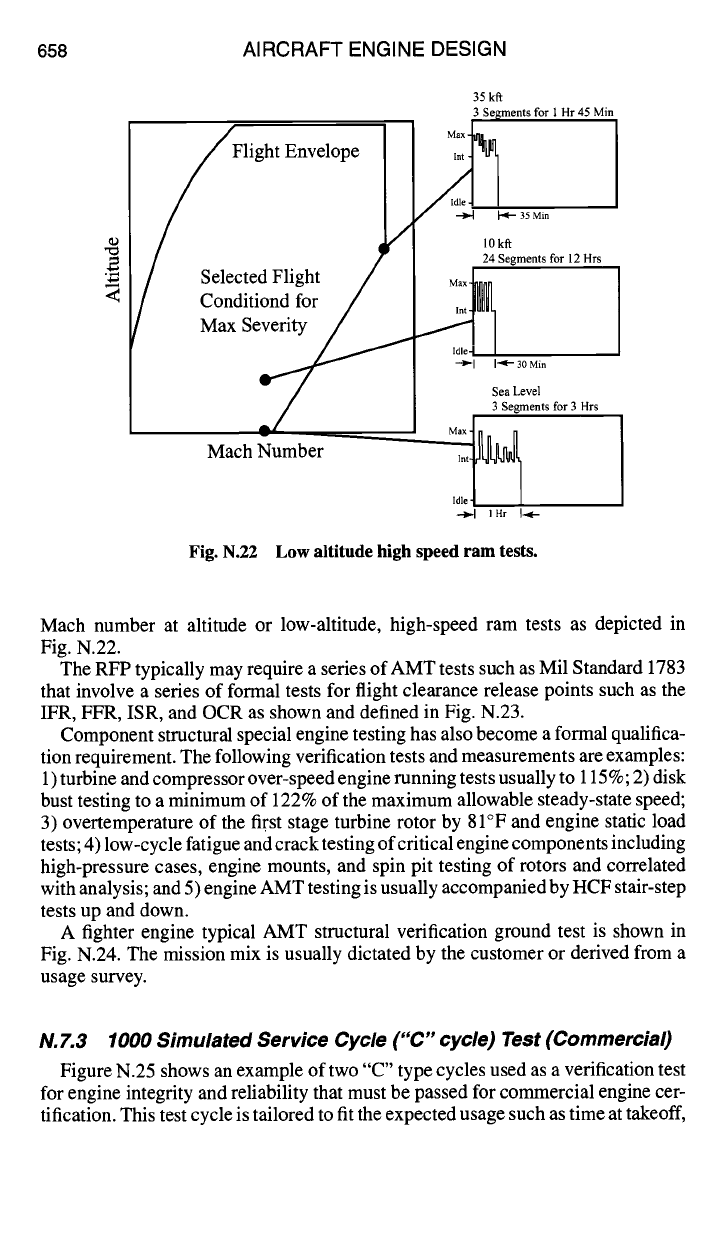
658 AIRCRAFT ENGINE DESIGN
Flight Envelope
/ Selected Flight /
, Max / C°ndiste° ~
Mach Number
35 kit
3 Se[ments for 1 Hr 45 Min
Max
Int
~~'~'- 35 Min
10 kit
24 Segments for 12 Hrs
Max
lnt
--~l I "~r- 30 Min
Sea Level
3 Segments for 3 Hrs
Int
Id
-~'-I I Hr I~-
Fig. N.22 Low altitude high speed ram tests.
Mach number at altitude or low-altitude, high-speed ram tests as depicted in
Fig. N.22.
The RFP typically may require a series of AMT tests such as Mil Standard 1783
that involve a series of formal tests for flight clearance release points such as the
IFR, FFR, ISR, and OCR as shown and defined in Fig. N.23.
Component structural special engine testing has also become a formal qualifica-
tion requirement. The following verification tests and measurements are examples:
1) turbine and compressor over-speed engine running tests usually to 115 %; 2) disk
bust testing to a minimum of 122% of the maximum allowable steady-state speed;
3) overtemperature of the first stage turbine rotor by 8 I°F and engine static load
tests; 4) low-cycle fatigue and crack testing of critical engine components including
high-pressure cases, engine mounts, and spin pit testing of rotors and correlated
with analysis; and 5) engine AMT testing is usually accompanied by HCF stair-step
tests up and down.
A fighter engine typical AMT structural verification ground test is shown in
Fig. N.24. The mission mix is usually dictated by the customer or derived from a
usage survey.
N.7.3 1000 Simulated Service Cycle ("C" cycle) Test (Commercial)
Figure N.25 shows an example of two "C" type cycles used as a verification test
for engine integrity and reliability that must be passed for commercial engine cer-
tification. This test cycle is tailored to fit the expected usage such as time at takeoff,
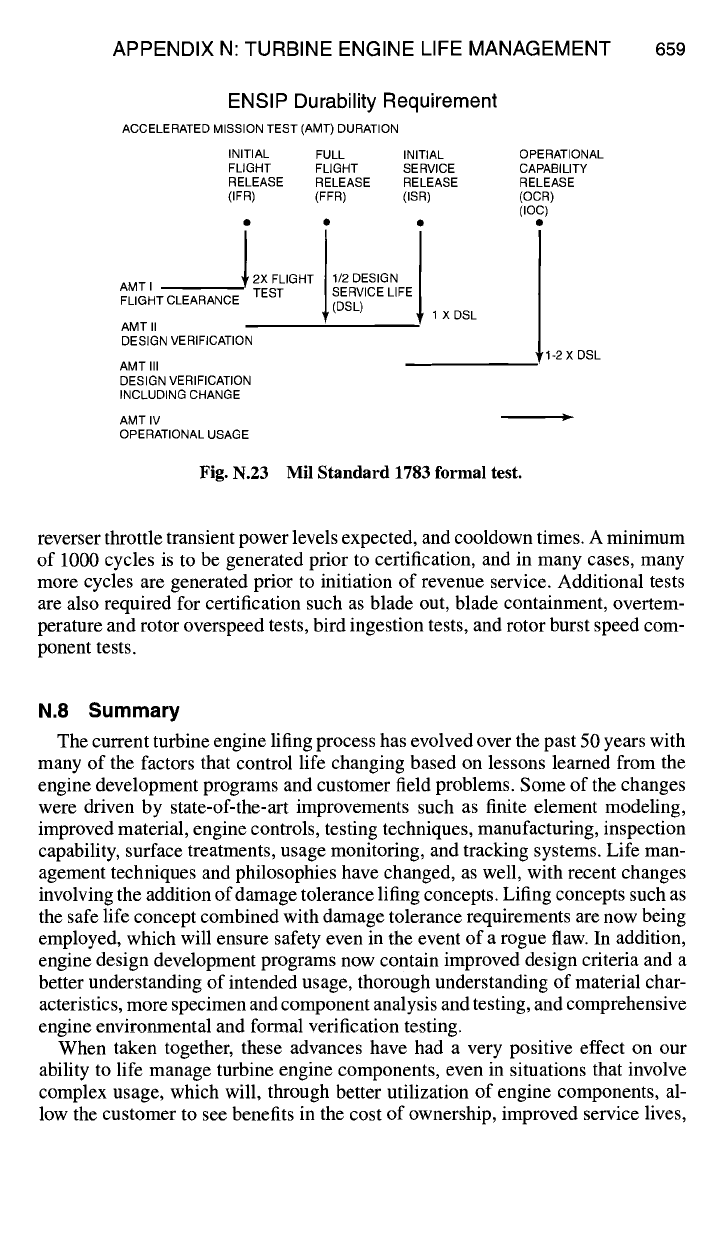
APPENDIX N: TURBINE ENGINE LIFE MANAGEMENT 659
ENSIP Durability Requirement
ACCELERATED MISSION TEST (AMT) DURATION
INITIAL FULL INITIAL
FLIGHT FLIGHT SERVICE
RELEASE RELEASE RELEASE
(IFR) (FFR) (ISR)
AMTIFLIGHT CLEARANCE TEST
I
SERVICE LIFE [
/
(DSL)
/
.'~
I
X DSL
AMT II
DESIGN VERIFICATION
AMT III
DESIGN VERIFICATION
INCLUDING CHANGE
AMT IV
OPERATIONAL USAGE
OPERATIONAL
CAPABILITY
RELEASE
(OCR)
(lOG)
Q
' 1-2 X DSL
Fig. N.23 Mil Standard 1783 formal test.
reverser throttle transient power levels expected, and cooldown times. A minimum
of 1000 cycles is to be generated prior to certification, and in many cases, many
more cycles are generated prior to initiation of revenue service. Additional tests
are also required for certification such as blade out, blade containment, overtem-
perature and rotor overspeed tests, bird ingestion tests, and rotor burst speed com-
ponent tests.
N.8 Summary
The current turbine engine lifing process has evolved over the past 50 years with
many of the factors that control life changing based on lessons learned from the
engine development programs and customer field problems. Some of the changes
were driven by state-of-the-art improvements such as finite element modeling,
improved material, engine controls, testing techniques, manufacturing, inspection
capability, surface treatments, usage monitoring, and tracking systems. Life man-
agement techniques and philosophies have changed, as well, with recent changes
involving the addition of damage tolerance lifing concepts. Lifing concepts such as
the safe life concept combined with damage tolerance requirements are now being
employed, which will ensure safety even in the event of a rogue flaw. In addition,
engine design development programs now contain improved design criteria and a
better understanding of intended usage, thorough understanding of material char-
acteristics, more specimen and component analysis and testing, and comprehensive
engine environmental and formal verification testing.
When taken together, these advances have had a very positive effect on our
ability to life manage turbine engine components, even in situations that involve
complex usage, which will, through better utilization of engine components, al-
low the customer to see benefits in the cost of ownership, improved service lives,
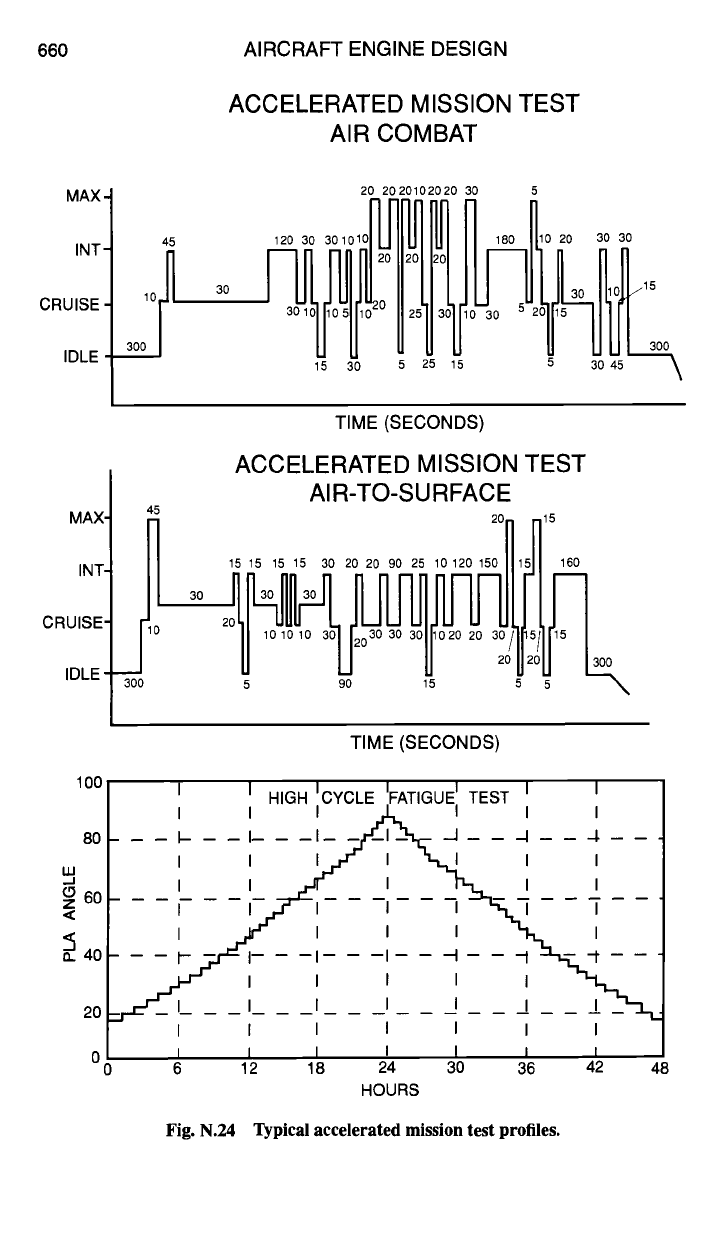
660
AIRCRAFT
ENGINE DESIGN
ACCELERATED MISSION TEST
AIR COMBAT
MAX-
INT-
CRUISE
IDLE
45
3OO
30
20 2020102020 30
o o ooon if
3 2.'
15 30
5
~ 180 []10 20 30 30
3ogo o T UUl
25 15 5 30 45 \
\
MAX"
INT-
CRUISE"
I
IDLE
300
45
30
TIME (SECONDS)
ACCELERATED MISSION TEST
AI R-TO-S U RFACE
20 15
R l
15 15 15 15 30 20 20 90 25 10 120 150 11151l 160
~Oll ~o~"o~o ~o~ I~oVO~ ~lfo~o ~ ~o"~
TIME (SECONDS)
100
80 - -- --
UJ
~9 60
Z
<
~40 - -- --
20
I I I I I I I
0 I I I I I i I
0 6 12 18 24 30 36 42
HOURS
I HIGH ICYCLE iFATIGUEI TEST I
I I ~ I I
,. _l -f-,-~ - 4
48
Fig. N.24 Typical accelerated mission test profiles.
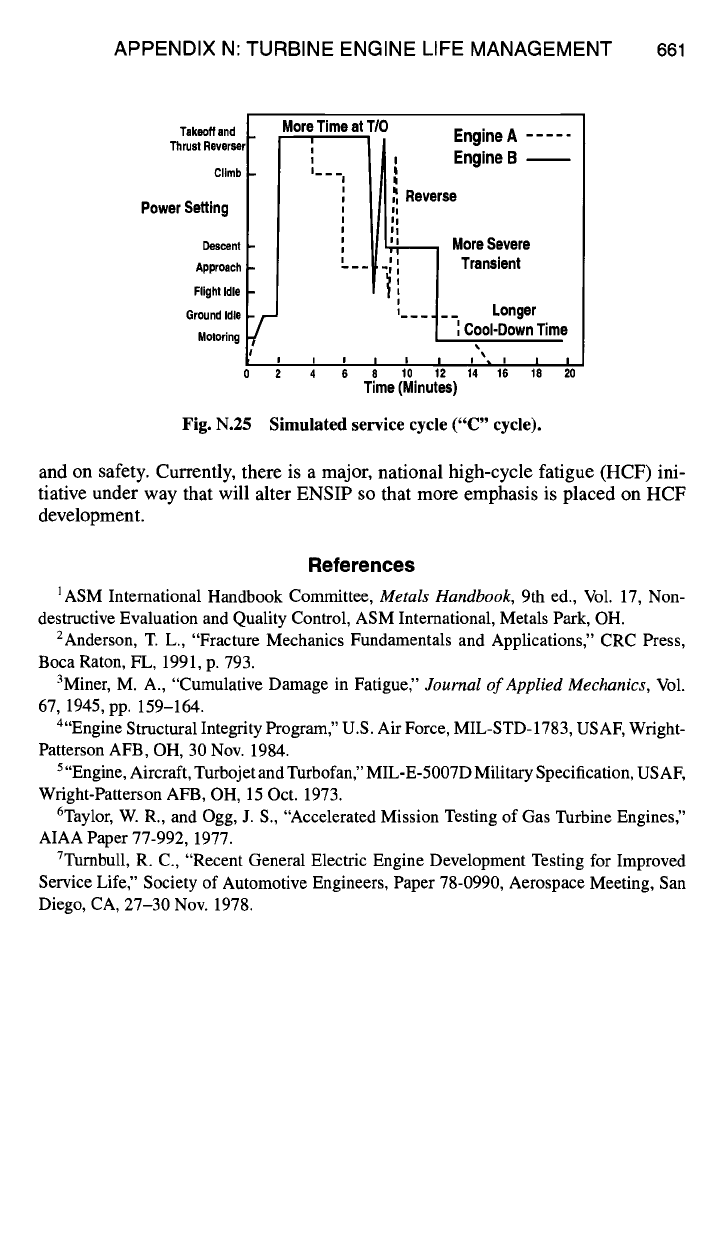
APPENDIX N: TURBINE ENGINE LIFE MANAGEMENT 661
Takeoff
and
Thrust Reverser
Climb
Power Setting
Descent
Approach
Flight
Idle
Ground
Idle
Motoring
Fig. N.25
More Time at T/O
, Engine A
.....
I
, 0 Engine B
I___ t
|
/ ~
Reverse
II
II
II
~', More Severe
--" t", ] Transient
_J : Longer
'
.....
-,' Cool-Down Time
, , , , , ; ,'., , ,
2 4 6 8 1 14 16 18 20
Time (Minutes)
Simulated service cycle ("C" cycle).
and on safety. Currently, there is a major, national high-cycle fatigue (HCF) ini-
tiative under way that will alter ENSIP so that more emphasis is placed on HCF
development.
References
]ASM International Handbook Committee,
Metals Handbook,
9th ed., Vol. 17, Non-
destructive Evaluation and Quality Control, ASM International, Meta]s Park, OH.
2Anderson, T. L., "Fracture Mechanics Fundamentals and Applications," CRC Press,
Boca Raton, FL, 1991, p. 793.
3Miner, M. A., "Cumulative Damage in Fatigue,"
Journal of Applied Mechanics,
Vol.
67, 1945, pp. 159-164.
4"Engine Structural Integrity Program," U.S. Air Force, MIL-STD- 1783, USAF, Wright-
Patterson AFB, OH, 30 Nov. 1984.
5,,Engine, Aircraft, Turbojet and Turbofan," MIL-E-5007D Military Specification, USAF,
Wright-Patterson AFB, OH, 15 Oct. 1973.
6Taylor, W. R., and Ogg, J. S., "Accelerated Mission Testing of Gas Turbine Engines,"
AIAA Paper 77-992, 1977.
7Tumbull, R. C., "Recent General Electric Engine Development Testing for Improved
Service Life," Society of Automotive Engineers, Paper 78-0990, Aerospace Meeting, San
Diego, CA, 27-30 Nov. 1978.
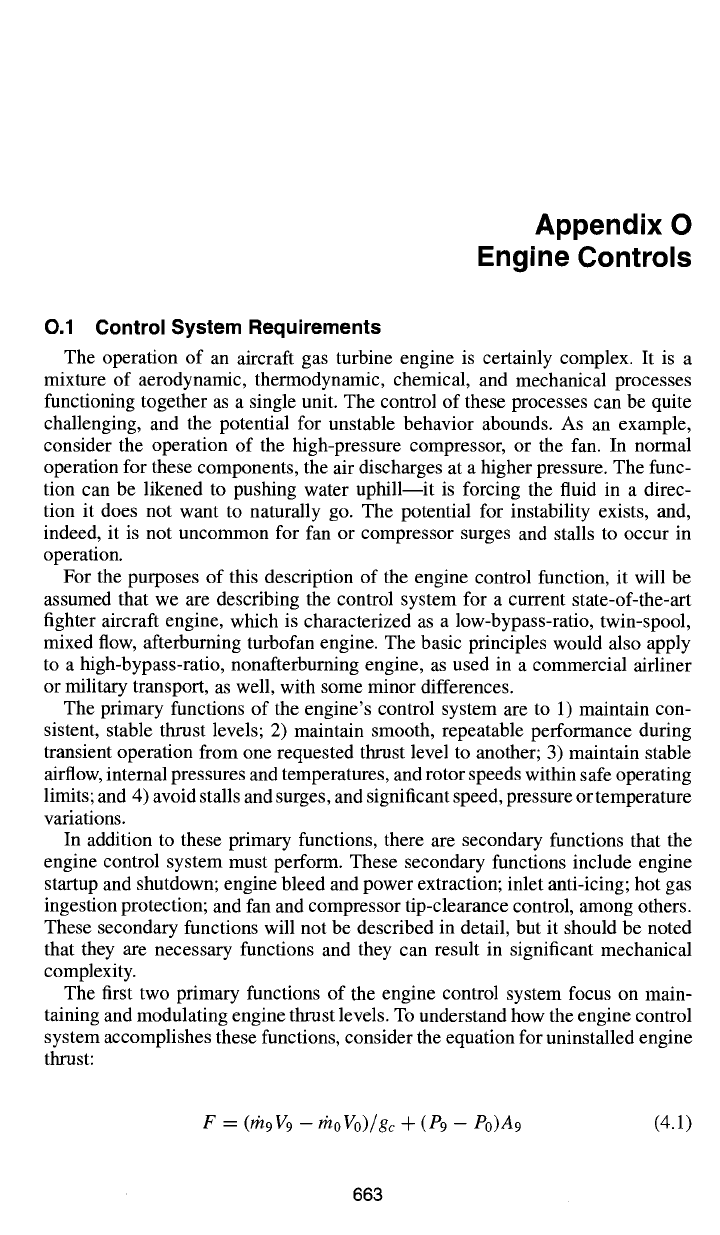
Appendix 0
Engine Controls
0.1 Control System Requirements
The operation of an aircraft gas turbine engine is certainly complex. It is a
mixture of aerodynamic, thermodynamic, chemical, and mechanical processes
functioning together as a single unit. The control of these processes can be quite
challenging, and the potential for unstable behavior abounds. As an example,
consider the operation of the high-pressure compressor, or the fan. In normal
operation for these components, the air discharges at a higher pressure. The func-
tion can be likened to pushing water uphill--it is forcing the fluid in a direc-
tion it does not want to naturally go. The potential for instability exists, and,
indeed, it is not uncommon for fan or compressor surges and stalls to occur in
operation.
For the purposes of this description of the engine control function, it will be
assumed that we are describing the control system for a current state-of-the-art
fighter aircraft engine, which is characterized as a low-bypass-ratio, twin-spool,
mixed flow, afterburning turbofan engine. The basic principles would also apply
to a high-bypass-ratio, nonafterburning engine, as used in a commercial airliner
or military transport, as well, with some minor differences.
The primary functions of the engine's control system are to 1) maintain con-
sistent, stable thrust levels; 2) maintain smooth, repeatable performance during
transient operation from one requested thrust level to another; 3) maintain stable
airflow, internal pressures and temperatures, and rotor speeds within safe operating
limits; and 4) avoid stalls and surges, and significant speed, pressure or temperature
variations.
In addition to these primary functions, there are secondary functions that the
engine control system must perform. These secondary functions include engine
startup and shutdown; engine bleed and power extraction; inlet anti-icing; hot gas
ingestion protection; and fan and compressor tip-clearance control, among others.
These secondary functions will not be described in detail, but it should be noted
that they are necessary functions and they can result in significant mechanical
complexity.
The first two primary functions of the engine control system focus on main-
taining and modulating engine thrust levels. To understand how the engine control
system accomplishes these functions, consider the equation for uninstalled engine
thrust:
F = (rh9g 9
--
rhoVo)/gc + (P9 - Po)A9
(4.1)
663
